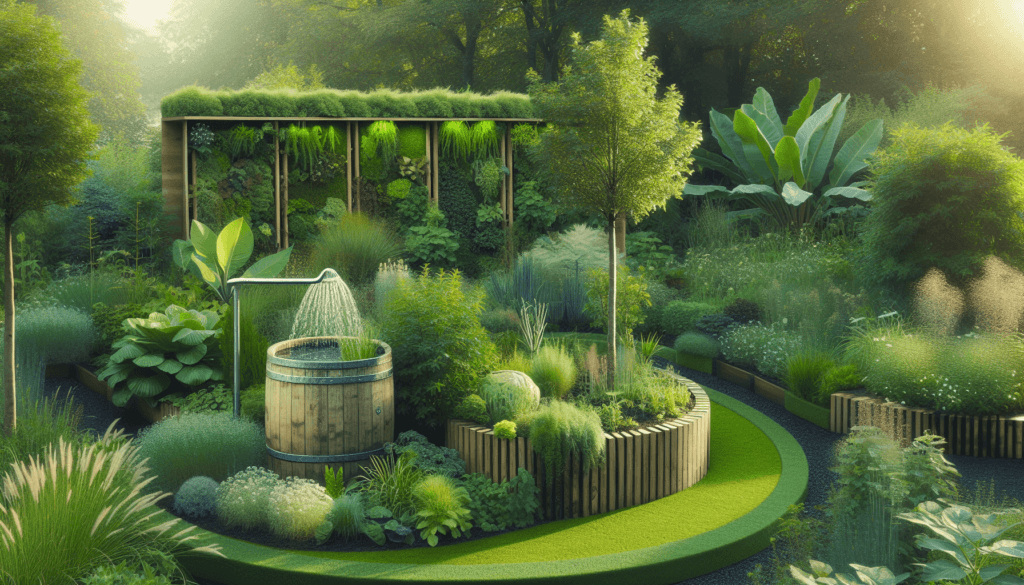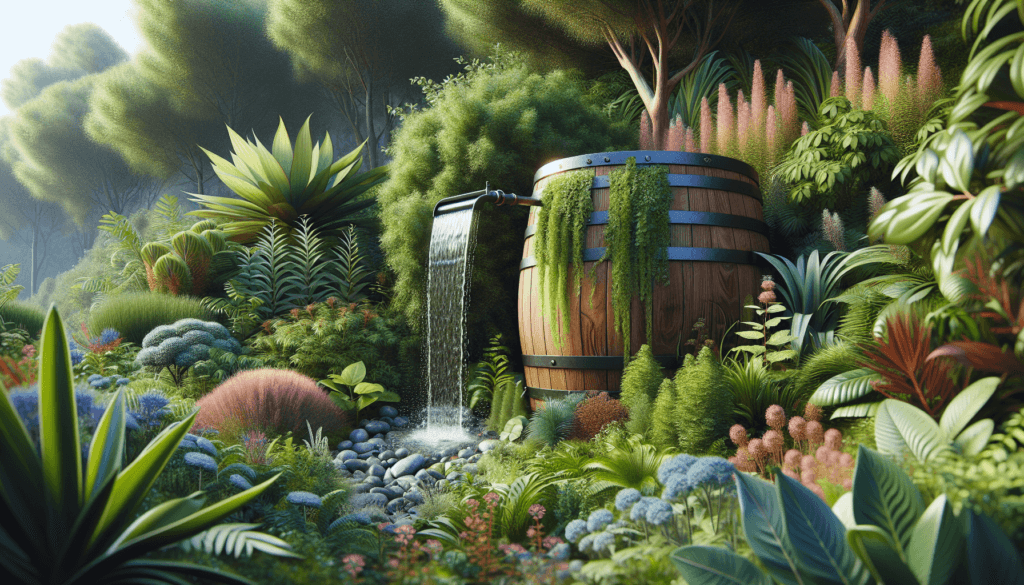Are you looking to create a beautiful garden that requires minimal effort and is environmentally friendly? Look no further! In this article, you will find a collection of helpful tips on how to create a low-maintenance eco-friendly garden. From selecting the right plants to conserving water, these tips will not only save you time and effort but also contribute towards a more sustainable and greener environment. So, let’s dive in and discover how you can create a garden that is both easy to maintain and eco-friendly!
Choose Native Plants
Research Local Native Plant Species
When designing an eco-friendly garden, it is crucial to choose native plant species that are well-suited to your local climate and soil conditions. Native plants have adapted to the conditions of their specific regions, making them more resilient and less dependent on excessive watering, fertilizers, and pesticides. By doing some research and identifying the native plants in your area, you can create a garden that thrives naturally without relying on excessive maintenance.
Benefits of Native Plants
There are numerous benefits to incorporating native plants into your garden. Firstly, native plants provide essential habitat and food sources for local wildlife, such as birds, butterflies, and bees. By planting native species, you can support the biodiversity of your area and help sustain these important ecological relationships.
Additionally, native plants are generally more resistant to pests and diseases, reducing the need for chemical pesticides and herbicides. They also require less water, as they are adapted to the local climate, which can help conserve this precious resource. Furthermore, native plants often have deep root systems that help prevent soil erosion and capture rainwater, contributing to a more sustainable garden ecosystem.
How to Incorporate Native Plants in Your Garden
Incorporating native plants into your garden is relatively easy. Start by researching the native plant species that are suitable for your region and make a list of the ones that appeal to you. Consider factors such as their bloom time, height, and color to ensure you have a diverse and visually appealing garden throughout the year.
Once you have made your selections, visit local nurseries or native plant sales to obtain the plants. When planting them, take into account their specific sunlight and soil requirements, and group them accordingly. By planting native species together, you can create a beautiful garden that mirrors the natural plant communities found in your region.
Reduce Water Usage
Install Drip Irrigation
One effective way to reduce water usage in your garden is by installing a drip irrigation system. Drip irrigation delivers water directly to the roots of plants through a network of tubes with small holes or emitters. This method significantly minimizes water wastage by avoiding evaporation and runoff commonly associated with traditional sprinkler systems.
Drip irrigation can be easily installed in both small gardens and larger landscapes, providing targeted watering exactly where it is needed. By ensuring that water is delivered efficiently and directly to the root zone, this method helps plants develop deep and healthy root systems, further reducing their water requirements.
Collect Rainwater
Collecting rainwater is another practical method to reduce water usage in your garden. Set up rain barrels or large containers connected to your home’s downspouts to capture rainwater. This harvested water can then be used to supplement your garden’s irrigation needs during dry spells, reducing your reliance on municipal water sources.
Rainwater is naturally soft and free of chemicals, making it an ideal source of water for your plants. By collecting and using rainwater, you not only conserve water but also minimize stormwater runoff, which can carry pollutants and contribute to water pollution.
Choose Drought-Tolerant Plants
Selecting drought-tolerant plants is a smart strategy for reducing water usage in your garden. These plants have evolved to survive in arid conditions and require minimal watering once established. Some popular drought-tolerant plant options include lavender, succulents, ornamental grasses, and Mediterranean herbs.
When planting drought-tolerant species, ensure the soil is well-drained to prevent waterlogging, which can be detrimental to these plants’ health. Applying a layer of organic mulch around them will also help retain moisture in the soil, further minimizing the need for frequent watering.

Practice Organic Gardening
Avoid Chemical Pesticides and Herbicides
A key principle of eco-friendly gardening is to avoid the use of chemical pesticides and herbicides. These conventional products can be harmful to the environment, including beneficial insects, soil microorganisms, and even humans. Instead, opt for natural alternatives such as insecticidal soap, horticultural oils, or homemade remedies like garlic spray or neem oil.
Use Organic Fertilizers
Another aspect of organic gardening is the use of organic fertilizers. These natural fertilizers, derived from plant and animal sources, release nutrients slowly and enrich the soil over time. Examples include compost, manure, bone meal, and seaweed extract. Organic fertilizers not only provide essential nutrients to your plants but also improve soil health, promote beneficial microorganisms, and reduce the risk of nutrient runoff into waterways.
Implement Companion Planting
Companion planting is a practice that involves planting different species together to promote their mutual benefit. Certain plant combinations can help repel pests, attract beneficial insects, enhance soil fertility, and deter diseases. For example, planting marigolds alongside tomatoes can repel insects, while growing beans near corn can fix nitrogen in the soil.
Research common companion planting combinations for your garden and experiment with compatible plant groupings. By incorporating companion planting into your garden design, you can naturally support plant health and reduce the need for chemical interventions.
Create a Wildlife Habitat
Attract Birds with Feeders and Nesting Boxes
Creating a wildlife-friendly garden involves providing food and nesting opportunities for local birds. Hang bird feeders filled with seed, suet, or nectar to attract a variety of bird species. Different types of feeders and feed can attract specific birds, so consider the bird species you want to attract when selecting your feeders and food sources.
Additionally, installing nesting boxes in suitable locations around your garden can provide shelter and nesting sites for birds. Research the nesting requirements of different bird species in your region to ensure you provide suitable nesting boxes for their specific needs.
Provide Water Sources for Wildlife
Water is essential for wildlife survival, and incorporating water sources in your garden can help attract and support local wildlife. Install a birdbath, small water feature, or shallow pond to provide drinking and bathing opportunities for birds, butterflies, and other wildlife. Ensure the water source has sloped edges or shallow areas to allow easy access and escape for smaller creatures.
Consider adding stones or sticks to your water feature to provide perching spots or create gradual slopes for easy entry and exit. Regularly clean and refill the water source to ensure it remains fresh and uncontaminated.
Include Native Plants that Support Pollinators
To create a garden that supports and attracts pollinators such as bees, butterflies, and hummingbirds, incorporate native plants that provide nectar, pollen, and hosting sites. These plants serve as essential food sources for pollinators and contribute to their survival and reproduction.
Research native plant species that are known to attract pollinators in your area and plant them strategically throughout your garden. Clustering these plants together will create attractive and easily accessible food sources for pollinators. Additionally, avoid using pesticides on or near these plants to protect the health of the visiting pollinators.

Use Mulch and Groundcovers
Benefits of Mulching
Mulching is a practice that involves covering the soil surface around plants with a layer of organic material. This organic mulch offers numerous benefits, including conserving soil moisture, suppressing weed growth, moderating soil temperature extremes, and promoting soil health.
Mulching helps retain moisture in the soil by reducing evaporation, thus reducing the need for frequent watering. It also acts as a natural weed suppressant by blocking sunlight and preventing weed seeds from germinating. Additionally, organic mulch breaks down over time and adds valuable organic matter to the soil, improving its fertility and structure.
Types of Organic Mulch
There are various types of organic mulch you can use in your garden. Some popular options include wood chips, straw, shredded leaves, grass clippings, and compost. Each type has its unique characteristics, so consider factors such as appearance, availability, and compatibility with your plantings when selecting a mulch type.
For example, wood chips are long-lasting and visually appealing but may take longer to break down and contribute to the soil. On the other hand, grass clippings or shredded leaves are readily available and quickly decompose, adding nutrients to the soil.
Selecting Groundcovers for Low Maintenance
Groundcovers not only add visual interest to your garden but also provide numerous benefits, including weed suppression, erosion control, and moisture conservation. When selecting groundcovers, opt for low-maintenance options that require minimal watering and pruning.
Some suitable groundcover choices include creeping thyme, vinca minor, sedum, and creeping juniper. These plants are known for their ability to spread and cover large areas, providing a carpet-like effect that minimizes soil erosion and weed growth.
Implement Efficient Garden Design
Group Plants with Similar Watering Needs
Efficient garden design involves grouping plants with similar watering needs together. This practice ensures that plants receive the appropriate amount of water, reducing water waste and promoting plant health. By avoiding mixed plantings with varying water requirements, you can streamline your watering efforts and prevent overwatering or underwatering certain plant species.
When designing your garden, consider the moisture needs of different plants and arrange them accordingly. Grouping plants that prefer dry conditions, such as succulents or Mediterranean species, in one area, and those that require more water in another, will allow for targeted watering and efficient water usage.
Use Raised Beds or Containers
Raised beds and containers are excellent options for efficient gardening, particularly in small spaces or areas with challenging soil conditions. These elevated planters allow for better control over soil quality and moisture levels.
Raised beds offer improved drainage and aeration, making them ideal for growing vegetables, herbs, or flowers. Additionally, the contained nature of raised beds helps prevent weed intrusion and minimizes the need for excessive watering as water is retained within the bed.
Containers, on the other hand, provide the flexibility to move plants around, follow the sunlight, or maximize limited space. Select containers with proper drainage holes and use lightweight, well-draining potting soil for optimum plant health.
Create Pathways for Easy Access
When planning your garden layout, consider incorporating well-designed pathways for easy access and maintenance. By creating clear paths between planting areas, you can navigate your garden easily and reduce the risk of trampling or damaging your plants.
Pathways can be made with various materials, such as gravel, pavers, or mulch. Choose a material that complements your garden aesthetic and ensures good drainage. Additionally, consider adding stepping stones or edging along the pathways to define the walkways and prevent soil erosion.

Install Efficient Lighting
Choose Energy-Efficient Outdoor Lighting
Efficient outdoor lighting can enhance the ambiance and functionality of your garden while minimizing energy consumption. When selecting outdoor lighting fixtures, opt for energy-efficient options such as LED (Light Emitting Diode) lights. LED lights are known for their longevity, low energy consumption, and reduced heat output compared to traditional incandescent or halogen lights.
LED lights are available in various colors and intensities, allowing you to customize the lighting according to your preferences. Additionally, they are compatible with solar and motion sensor systems, providing further opportunities to reduce energy usage and increase convenience.
Utilize Solar-Powered Lights
Solar-powered lights are an excellent eco-friendly alternative to traditional electrical lighting. These lights harness solar energy during the day and use it to illuminate your garden at night. Solar-powered lights are wireless, easy to install, and can be placed in any desired location, as long as they receive adequate sunlight during the day.
By utilizing solar-powered lights, you can reduce your reliance on electricity and minimize your carbon footprint. Additionally, solar lights often have automatic sensors that turn them on at dusk and off at dawn, providing hassle-free lighting without the need for manual operation.
Use Motion Sensors
Installing motion sensor lights in your garden can contribute to both energy savings and enhanced security. Motion sensor lights only activate when they detect movement, ensuring that lighting is only used when needed. This not only conserves energy but also helps deter potential intruders or unwanted wildlife.
Motion sensor lights can be strategically placed around your garden entrance, pathways, or near sensitive areas. They provide instant illumination whenever motion is detected, offering a sense of safety and security while avoiding unnecessary energy consumption.
Compost and Recycle
Create a Compost Bin
Composting is a sustainable way to manage garden waste and create nutrient-rich soil amendments. Start by setting up a compost bin in a convenient location within your garden. This can be a simple homemade structure made from wooden pallets or a store-bought compost bin.
Collect organic materials such as fruit and vegetable scraps, coffee grounds, eggshells, yard trimmings, and shredded paper to add to your compost bin. Avoid adding meat, dairy products, or oily materials, as these can attract pests or slow down the composting process. Regularly turn and aerate the compost to encourage decomposition, and within a few months, you will have nutrient-rich compost to use in your garden beds.
Recycle Yard Waste
In addition to composting, recycling yard waste is an essential practice in eco-friendly gardening. Rather than throwing away grass clippings, fallen leaves, or pruned branches, repurpose them as mulch or organic material for your garden.
Grass clippings can be left on the lawn as natural fertilizer or used as a mulch around plants. Fallen leaves can be shredded and added to compost or used as a protective layer around plants during winter. Larger branches and twigs can be chipped or shredded and used as pathways or as a base layer for compost bins.
Reuse Materials in the Garden
Reusing materials in your garden not only helps minimize waste but also adds a creative touch to your outdoor space. Look for opportunities to repurpose items such as old wooden furniture, salvaged bricks, wine barrels, or vintage containers as decorative or functional elements in your garden.
For example, an old wooden ladder can be transformed into a vertical garden by placing pots or containers on each step. Salvaged bricks can be used to build raised beds or border pathways. Wine barrels can be converted into striking planters for herbs or flowers. By giving new life to these discarded materials, you can create a unique and environmentally conscious garden design.

Manage Weeds Naturally
Mulch to Suppress Weeds
Mulching not only conserves moisture and improves soil health but also acts as a natural weed suppressant. By covering the soil surface with a layer of organic mulch, you block sunlight and prevent weed seeds from receiving the necessary light for germination.
Apply a thick layer of mulch, approximately 2-4 inches deep, around your plants, ensuring the soil is covered but leaving space around the plant’s base to prevent stem rot. This will effectively smother weed growth and reduce the need for manual weeding or herbicide use.
Hand Weed Regularly
To manage weeds effectively and minimize their spread, regular hand weeding is necessary. Set aside some time each week to walk through your garden and manually remove any visible weeds. Be sure to pull the weeds from the root to prevent regrowth.
Hand weeding is particularly important when weeds are still small or before they flower and produce seeds. By consistently removing weeds before they reproduce, you can prevent them from becoming a more significant problem in your garden.
Use Organic Weed Control Methods
If hand weeding alone is insufficient for controlling weeds, consider employing organic weed control methods as a supplementary measure. There are various natural alternatives to chemical herbicides that can effectively manage weeds without harming the environment or beneficial organisms.
For example, boiling water can be poured directly onto weed-infested areas, effectively killing the weeds by scalding them. Vinegar-based weed killers or homemade herbicidal soap sprays can also be applied selectively to weed foliage, dehydrating and killing them. Be cautious when using these organic weed control methods to avoid damaging nearby desirable plants.
Minimize Lawn Area
Consider Alternatives to Traditional Lawns
Minimizing the size of your lawn can significantly reduce water usage, maintenance requirements, and overall environmental impact. Consider incorporating alternative ground covers or landscape features that require less water and upkeep while still providing visual interest.
Ground cover options such as clover, creeping thyme, or ornamental grasses can serve as attractive and low-maintenance alternatives to the traditional grass lawn. These options often require less water, are more resistant to drought, and help support local pollinators and wildlife.
Install Artificial Turf or Gravel
For those seeking an even lower-maintenance option, installing artificial turf or gravel can be an effective solution. Artificial turf provides the look and feel of a lush lawn without the need for watering, mowing, or fertilizing. It remains green and vibrant year-round, eliminating the need for herbicides and reducing water consumption.
Gravel or pea gravel can be used in place of a traditional lawn to create a modern and minimalist landscape. Gravel requires minimal upkeep and can be visually enhanced with the addition of drought-tolerant plants or decorative features.
Create Functional Outdoor Living Spaces
Another way to reduce lawn area is by creating functional outdoor living spaces. Consider repurposing a portion of your lawn to build a patio, deck, or seating area. These spaces not only reduce lawn maintenance but also provide areas for relaxation, dining, or entertaining.
Integrate seating, tables, and outdoor amenities such as a fire pit, grill, or water feature to create a personalized and inviting outdoor oasis. Surround these spaces with low-maintenance plants, like dwarf shrubs or container gardens, to soften the hardscape and add beauty to your outdoor retreat.
By following these tips for creating a low-maintenance eco-friendly garden, you can create a sustainable and beautiful outdoor space that not only minimizes your environmental impact but also enhances your enjoyment and connection with nature. With the right plant selections, water management strategies, organic gardening practices, and thoughtful design elements, your garden can become a haven for wildlife, a source of joy, and a reflection of your commitment to a greener future.



